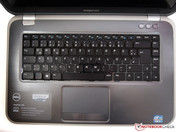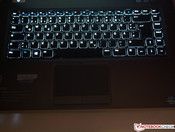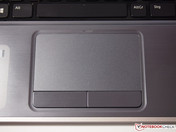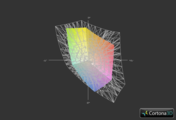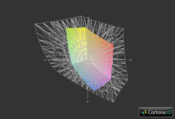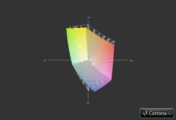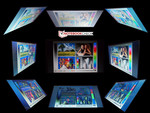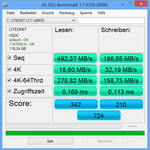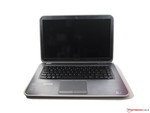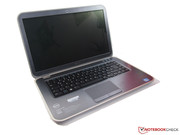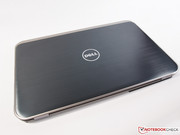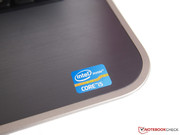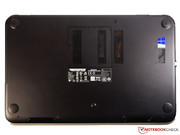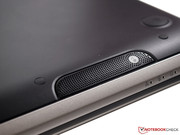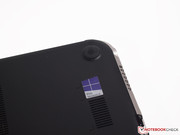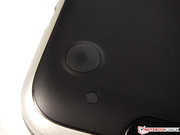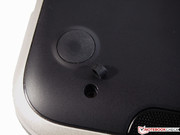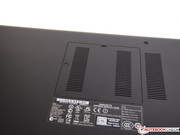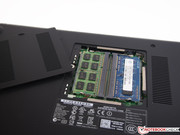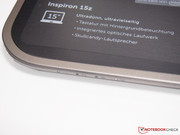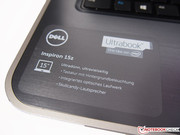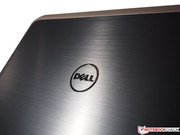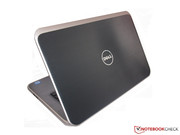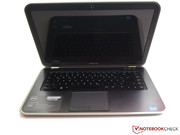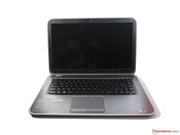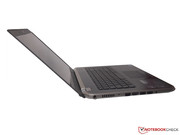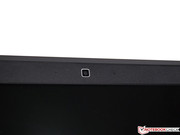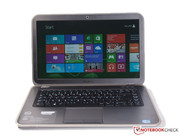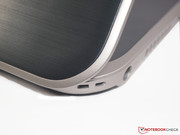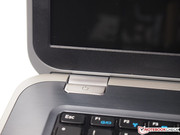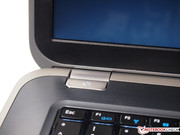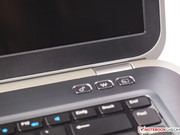Review Dell Inspiron 15z (5523) Ultrabook

For the original German review, see here.
The thin line between ultrabooks and multimedia notebooks is gradually disappearing. First came the elegant Zenbooks that emulated the genre leader MacBook Air. The ultrabooks of today are a bit thicker and heavier, due to the additional equipment such as DVD drive and 15.6-inch screen. Both of these are characteristics of the broad class of multimedia notebooks. But the usual ultrabook features are also not neglected: Solid State Drives or hard drives with ExpressCache offer quick system start-up. At about 2 kg, the Dell Inspiron 15z 5523 is approximately one kilogram lighter than most 15.6-inch notebooks. The predecessor with the same name, Inspiron 15z, was still a classical multimedia notebook.
As with all its devices, Dell offers an individually configurable notebook. Our Inspiron 15z 5523 comes with the cheapest available processor Intel Core i5-3317U – a ULV CPU of the current Ivy Bridge generation with a good price-performance ratio. It also houses the graphics chip Intel HD Graphics 4000, which is augmented by the dedicated Nvidia GeForce GT 630M with 2 GB of video memory. The total system memory available is 6 GB, composed of one 4 GB and one 2 GB modules, occupying both RAM slots. In addition Dell's ultrabook comes with a 128 GB Solid State Drive, of which at least 18 GB is taken up by Windows 8 Pro (64 bit).
In this configuration, the Inspiron 15z is available for 749 Euros (~$1008) on Dell's website. Those who are happy with just the integrated graphics chip and the conventional 500 GB hard drive, can save exactly 100 Euros (~$134). An upgrade of our configuration to the Intel i7-3517U costs 50 Euros (~$67).
Case
The Inspiron 15z looks like a proper ultrabook with its gray brushed aluminum display lid and palm rest. The well-rounded edges are a matter of taste. Although the metal surfaces are not as dirt prone as is high-gloss plastic, some fingerprints are still clearly visible. The same is true about dust on the glossy display, which is not an issue on matte screens. Thus, a cleaning cloth is a must-have accessory.
The fancy metal surfaces are protected by plastic around the edges and on the bottom cover, both of which feel quite solid. In addition, all the gaps are uniform and the Inspiron 15z can be awarded a good workmanship mark.
A 15-inch notebook, which at 23 mm is also very thin, will mostly have the disadvantage of a wobbly display. The Inspiron 15z is not an exception. When opening the 5 mm thin display lid, it feels like no teetering should be expected. But small vibrations prove the opposite. Still, the hinges hold the lid firmly in place and it can be comfortably opened with one hand. The maximum opening angle is only about 120 degrees.
Connectivity
As we already mentioned, the ultrabook has no less equipment than a multimedia notebook. The 15z features a DVD burner and a LAN port, which needed an adapter on most ultrabooks of the first generation. In addition, the notebook has a total of four USB ports - two on each side. The HDMI, Kensington Lock and the SD card reader were also not forgotten. We are only missing a VGA port, because external monitors and projectors do not always have an HDMI input. All of the interfaces are located on both sides and are not too close to each other. At the front the status LEDs glow discreetly in white.
Like most notebooks, the 15z also has a webcam above the display. It is nothing special with a resolution of 1.3 megapixels. Our test shows some noise in the picture despite the sufficient light. The quality is enough for Skype video calls, but nothing more. A small LED right next to the camera indicates operation. Thanks to the integrated microphone, you can easily "Skype" without any external accessories.
Communication
Dell has equipped the Inspiron 15z with a "Dell Wireless 1704" module that uses the latest WLAN and Bluetooth standards. The former supports 802.11b/g/n and we cannot ask more of it. But our test revealed some problems. At first the ultrabook could not connect to the access point, but that was resolved after a re-installation of the driver. The module also could not communicate well with our FritzBox, which is a couple of years old and supports the b/g standards. Although the tray icon said that the connection was stable, the internet access was interrupted at random intervals. A reboot of the module bought us some more internet time. There are different explanations of the problem on some internet forums, but unfortunately we could not find a solution for the period of the review. However, the connection to other access points was flawless.
The range of the WLAN module was rather mediocre. At a distance of 10 meters (~33 feet) and a wall between the router and the notebook, the wireless strength fluctuated between two and four bars out of five. With one floor and about two walls between the two devices, the ultrabook could not connect to the router at all. In comparison, both an old netbook with an Atheros module and the Samsung Galaxy Note 2 still had reception at this point.
The latest Bluetooth Version 4.0, which is more energy efficient than the widely used version 3.0, is also available. Annoyingly, Bluetooth and WLAN can only be switched off or on together and not separately via the Fn button.
Accessories
The ultrabook comes only with the essentials. In addition to the power supply and some printed materials, there is only a single DVD with drivers, which currently can also be downloaded off the internet. A Windows Recovery DVD could have been useful in order to quickly restore the system to its factory settings. Instead, we have the Windows Recovery function and Dell's "Backup and Recovery" at our disposal.
Maintenance
A small cover allows quick access to the system memory. The rest of the bottom side cannot be removed without the risk of damage. Therefore, attempting to do so is not advisable at least for amateurs. You cannot easily access the other components such as hard drive, graphics card, and fan.
Warranty
Dell delivers the Inspiron 15z with a two-year warranty. If you purchase the ultrabook directly from the manufacturer, you will also receive one year of the so-called On-Site Hardware Service, which promises "hardware repairs within one day". Also included are 90 days of over-the-phone support. For 75.01 Euros (~$100) it can be extended to one year. 97.50 Euros (~$131) pays for two years of On-Site Hardware Service and just as long phone support. Three years of both costs 180 Euros (~$242).
In addition, one year accident protection can be purchased for 40 Euros (~$53). Also, Dell offers software theft protection via the LoJack application. This of course only protects against inexperienced thieves that would continue to use the installed operating system.
Input Devices
Keyboard
The Inspiron 15z has a keyboard in the common chiclet style. It features low-profile square keys with rounded corners. The 3 mm gap between the keys separates them well and can prevent typos. The keys also have a clear pressure point, thus allowing convenient and quick typing. Generally, the good workmanship and keyboard quality go hand in hand. At the top right of the keyboard we find three special buttons. One opens the Windows Mobility Center, allowing quick access to the main modules of the notebook. The second one switches between the various sound settings. The third key is configurable and can start any program.
A highlight, in the truest sense of the word, is the keyboard's back lighting. It can be switched off completely or adjusted in two steps via an Fn key. If the keyboard has not been used for some time, the lighting automatically switches off and comes back on at the first key press.
Touchpad
The touchpad is slightly recessed into the body and visually fits well in the overall image of the notebook. The slightly rough surface is different optically and tactile from the brushed aluminum of the palm rest. Finger gliding is comfortable and the cursor movement is smooth. The familiar multi-touch gestures, such as two-finger scrolling or zooming, work well. The tray icon of the touchpad leads to an extensive menu, offering a variety of gestures with up to four fingers. In spite of all efforts, we could not make even one of them work. Only the two already mentioned gestures worked as advertised. The software seems incompatible with Windows 8 – we can only hope for an update.
The two mouse buttons are made of smooth plastic, but imitate the aluminum look of the case. They function perfectly, have a pleasant pressure point, and do not wobble. Overall, the touchpad corresponds to the good workmanship of the case.
Display
The screen has a diagonal of 15.6-inches and has a resolution of 1366x768 pixels in the 16:9 format. A higher resolution can often be found only in a device above the 1000 Euros (~$1346) mark. This is a glossy display, which hinders outdoor use. The values of the screen we measured prove that the image quality cannot compensate for this shortcoming. The maximum brightness of 212 cd/m² forces compromises in brightly lit places. The contrast ratio of 650:1 is surprisingly good for the moderate brightness values.
| |||||||||||||||||||||||||
Brightness Distribution: 91 %
Center on Battery: 214 cd/m²
Contrast: ∞:1 (Black: 0 cd/m²)
40% AdobeRGB 1998 (Argyll 3D)
57.5% sRGB (Argyll 3D)
39.02% Display P3 (Argyll 3D)
The low coverage of the sRGB and AdobeRGB color spaces is no surprise. Anyway, it is relevant only to professional graphics and photo editors. As expected, the color spaces are barely reproduced. Nevertheless, the Inspiron 15z is slightly better in this test than its smaller brother, the 14z.
While the viewing angles of the Inspiron 14z were abysmal, those of the 15z can be considered as acceptable. Horizontally, the image remains relatively stable up to 45 degrees. Vertically, we see a fading and color inversion even at a small angle. This is typical for notebooks with a TN panel. The rarely used IPS panels offer significantly better viewing angles, as the Lenovo ThinkPad Twist Convertible shows.
Performance
The heart of Dell's Inspiron 15z in our configuration is the Intel Core i5-3317U. It is a popular choice since it offers good value for money to most customers. The processor has two cores with a base clock of 1.7 GHz. At idle, the frequency is automatically reduced to 800 MHz and under high load Turbo Boost should increase it to 2.6 GHz (single core). The chip also houses the Intel Graphics HD 4000, which is used in simpler applications in order to save power. The dedicated Nvidia GeForce GT 630M comes with 2 GB video memory. Thanks to Nvidia Optimus technology it is automatically turned on for demanding video and 3D applications. As we already mentioned, the Inspiron also comes with 6 GB of RAM, which ought to be enough for most users. The 128 GB Solid State Drive is rather fast, but might be a bit too small as a storage device.
In this configuration, the Dell Inspiron 15z costs 749 Euros (~$1008). The cheapest version with Intel Core i3-3217U, 4 GB of RAM and a 500 GB hard drive with a 32 GB ExpressCache will set you back 599 Euros (~$806). The most powerful chip is the Intel Core i7-3517U, which Dell offers in the Inspiron 15z model starting from 949 Euros (~$1277).
Processor
Compared to other notebooks with the same processor, the Inspiron 15z shows a rather poor performance in the CPU benchmark Cinebench. The smaller Inspiron 14z or even the cheaper Asus Aspire V5-571G are about 50% quicker in the Single Rendering test. We saw the same results in both the 32 and 64 bit Multi Core tests.
According to the specifications, a single core should be able to reach 2.6 GHz and both cores - 2.4 GHz. But under continuous load, which the benchmark simulated, neither cores exceed the base clock. This is the reason for the relatively low scores. This also leads to performance loss in demanding applications. Some consolation comes from the fact that the frequency is not lower on battery power - the benchmarks showed the same results as when plugged in.
| Cinebench R10 - Rendering Single 32Bit (sort by value) | |
| Dell Inspiron 15z-5523 | |
| Dell Inspiron 14z (5423) | |
| Acer Aspire V5-571G-53314G50Makk | |
| Cinebench R11.5 - CPU Multi 64Bit (sort by value) | |
| Dell Inspiron 15z-5523 | |
| Dell Inspiron 14z (5423) | |
| Acer Aspire V5-571G-53314G50Makk | |
System Performance
The extensive benchmarks of the PCMark Vantage and PCMark 7 will serve as an indicator to the overall system performance. Unfortunately the 1.5-hour Vantage benchmark came up with no results, so here are the PCMark 7 ones. Compared to the aforementioned notebooks it is obvious that the poor CPU performance has no effect here. The score of the Inspiron 15z trumps all notebooks with the same CPU. The reason is the SSD - all of the other laptops use slower hybrid solutions with ExpressCache.
The advantage of the flash memory is noticeable especially in combination with Windows 8. Although the lack of a Start menu might be confusing to new users, the usual loading times for system and application start-up are almost non-existent. A cold start of the notebook takes a couple of seconds, little more than when waking from Sleep mode.
| PCMark 7 - Score (sort by value) | |
| Dell Inspiron 15z-5523 | |
| Dell Inspiron 14z (5423) | |
| Acer Aspire V5-571G-53314G50Makk | |
| Acer Aspire M5-581TG-53314G52Mass | |
| PCMark 7 Score | 3679 points | |
Help | ||
Storage Devices
Our test model comes with a Solid State Drive (SSD) made by Liteon (LCT-128M3S). The manufacturer promises maximum read and write speeds of over 500 MB/s. The sequential read rate we measured was 493 MB/s and the write one was only 187 MB/s. The first value is rather good for a flash drive. While the write rate was far from the advertised one, it should not matter that much to the overall performance.
As we already mentioned, the hybrid solution of a 500 GB hard drive and an ExpressCache costs 100 Euros (~$134) less. The small Inspiron 14z we tested came with a Solid State Drive made by Samsung that had similar read rates and slightly better write rates.
Graphics Card
In addition to the integrated Intel HD Graphics 4000, the Inspiron 15z can be equipped with the dedicated Nvidia GeForce GT 630M, as is our test model. It is an affordable graphics card of the lower middle class, which allows playing some games on the ultrabook. Automatic switching between the two graphics solutions is also possible thanks to Nvidia Optimus technology. The Intel chip is used for simple desktop applications and thus saves power and increases battery life. The dedicated GeForce card takes over during demanding HD movies or 3D applications.
The results from 3DMark 11 are as expected. The smaller Inspiron 14z is equipped with the somewhat slower AMD Radeon HD 7570M, which scored about 3/4 of the points of the GeForce. The slightly lower-clocked GeForce 620M of the aforementioned Acer Aspire V5-571G also has a similar score. The ultrabook Acer Aspire M5-581TG comes with a GeForce 640M. Its lead of 50% is due to the significantly higher number of Shaders and the new Kepler architecture. The 630M is part of Nvidia's previous Fermi generation.
| 3DMark 06 Standard Score | 7689 points | |
| 3DMark 11 Performance | 1214 points | |
Help | ||
| 3DMark 11 - 1280x720 Performance (sort by value) | |
| Dell Inspiron 15z-5523 | |
| Dell Inspiron 14z (5423) | |
| Acer Aspire V5-571G-53314G50Makk | |
| Acer Aspire M5-581TG-53314G52Mass | |
Gaming Performance
If we have a dedicated graphics card on board, we should be able to play some games on the ultrabook. Although, at this price, some compromises are to be expected. With the help of some older and some modern games, we test the gaming capabilities of the Inspiron 15z. First is Starcraft 2, which we played without significant frame rate drops. The game runs at 1024x768 pixels and low details with more than 100 fps. But even at native resolution and medium details it is still playable at 50 fps. Only at a higher setting would the game stutter in some demanding battles.
The Elder Scrolls V: Skyrim is a 2011 role playing game that is graphically more demanding. Yet it is playable at lower details and native resolution – even though the counter never exceeded 30 fps. Under load, as when playing Skyrim, the limitation of the CPU clock is the ultrabook's bottleneck for games.
Assassin's Creed 3 is a brand new title. It is playable on the Inspiron 15z at native resolution and medium details. You can find various gaming benchmarks on the GeForce GT 630M page, which should indicate basic gaming capabilities with some restrictions. Those who intend to play older or not so demanding games will find a good price-performance compromise with this card. But an ultrabook is generally the wrong choice for higher gaming demands.
| low | med. | high | ultra | |
|---|---|---|---|---|
| StarCraft 2 (2010) | 124 | 49 | 26 | |
| The Elder Scrolls V: Skyrim (2011) | 29 | 28 | 25 | |
| Assassin´s Creed III (2012) | 36 | 24 |
Emissions
Noise Level
Unlike a conventional hard drive, the SSD is completely silent, because there are no mechanical elements. This leaves the fan and the DVD drive, when used, as the Inspiron 15z's sources of noise. When working on a desktop, say with Office applications, the ultrabook remains pleasantly quiet. Only when playing games or under similar demanding applications does the fan spin up. The noise level we measured was 42 dB, which is a mediocre result. When playing a DVD, the drive is sporadically audible, but this does not disturb the movie experience in any way.
Noise level
| Idle |
| 29.5 / 31.4 / 31.6 dB(A) |
| DVD |
| 34.5 / dB(A) |
| Load |
| 39.1 / 42.3 dB(A) |
 | ||
30 dB silent 40 dB(A) audible 50 dB(A) loud |
||
min: | ||
Temperature
As you can see on the diagram, the only hot spot is on the bottom, round the AC jack, and it gets warm only when the notebook is under load. The keyboard and palm rest remain pleasantly cool, mainly because of the aluminum surface. We measured values not exceeding 30 °C. Higher temperatures were observed only on the bottom side. The smaller Inspiron 14z with the same processor gets a bit warmer under load.
During the stress test, we put the system under constant load with FurMark and Prime95. The CPU frequency limitation of the processor is justified here. In order to protect the hardware from overheating, the CPU is not allowed to exceed its base clock frequency. Even after one hour, the reported maximum temperature of the CPU was 80 °C – even 10 °C higher would not have been critical. If you run only Prime95 or FurMark, the processor reaches just 70 °C. Thus the fan does not have a lot of work, as in notebooks without such frequency limitation, and keeps the ultrabook constantly cool. The benchmarks we ran again right after the stress test showed results without significant deviation.
(-) The maximum temperature on the upper side is 45.2 °C / 113 F, compared to the average of 36.9 °C / 98 F, ranging from 21.1 to 71 °C for the class Multimedia.
(-) The bottom heats up to a maximum of 47.1 °C / 117 F, compared to the average of 39.2 °C / 103 F
(+) In idle usage, the average temperature for the upper side is 28.7 °C / 84 F, compared to the device average of 31.3 °C / 88 F.
(+) The palmrests and touchpad are cooler than skin temperature with a maximum of 29 °C / 84.2 F and are therefore cool to the touch.
(±) The average temperature of the palmrest area of similar devices was 28.7 °C / 83.7 F (-0.3 °C / -0.5 F).
Speakers
The stereo speakers, located beneath the front of the notebook, offer clear sound and can be turned up quite loud. The ultrabook lacks a subwoofer, which is getting more and more popular among multimedia notebooks and gives more bass. Like in the smaller 14z, a button allows the selection of various sound profiles. They do not really make a difference to the sound of the 15z either and are unnecessary. If you value better sound quality, we advise the use of external (active) speakers.
Energy Management
Power Consumption
At just 5.9 W the ultrabook has a properly low minimum consumption. In comparison, the smaller 14z draws a minimum of 7.4 W. The maximum energy consumption of the 15z is almost 47 W, which is about 10 W higher than the Inspiron 14z. The main reason is the powerful Nvidia graphics card. The maximum output of the power supply is 90 W, which is more than enough.
| Off / Standby | |
| Idle | |
| Load |
|
Key:
min: | |
Battery Life
As the already mentioned 14z, the Inspiron 15z comes with a built-in Lithium-Ion battery with a capacity of 44 Wh. Theoretically, given the minimum power consumption, the battery should last more than 7.5 hours. The actual time was measured with the Battery Eater Tool, which simulates reading a text document instead of absolutely idle state. With lowest screen brightness and disabled wireless modules, the battery lasted almost 7 hours.
A more practical scenario is offered by the surf test. We set the brightness on medium and let a script reload websites of different sizes. The Inspiron 15z was out of juice after 5 hours and 34 minutes. The ultrabook lasts almost half an hour less playing a DVD with the same brightness, but deactivated WLAN.
The minimum run time should be less than an hour, because the maximum consumption of the notebook is higher than the battery's capacity. The Classic test by Battery Eater showed 1 hour and 12 minutes. This shows that the ultrabook does not draw the maximum 46 W constantly, probably because of the CPU frequency limitation. Since this scenario is not realistic, the battery should last longer than this even in demanding applications.
Verdict
Dell has successfully integrated the ultrabook into the multimedia Inspiron family. The 15z bridges the gap between the two notebook classes without sacrificing too much on either side.
First off is the stylish appearance that deserves the title ultrabook. The brushed aluminum not only looks good, but also emphasizes the high quality of the case. It is remarkably thin for a 15-inch notebook and is also well built. The hardware components are also on an ultrabook level: the Intel Core i5-3317U is a processor with a good price-performance ratio, supported by the Nvidia GeForce GT 630M. Occasional gaming is also possible on the Inspiron 15z. The Solid State Drive in combination with Windows 8 makes working rather quick - the system boots in seconds and so do the other programs.
The display is less convincing. Due to its glossy surface and relatively low brightness, it is less than suitable for outdoor use. The performance of the notebook suffers from a CPU that is limited to its base clock, thus remaining below its potential. However, this ensures that the ultrabook is always cool and quiet. Also unsatisfactory is the pre-installed software. Under Windows 8 not all of the multi-touch gestures shown in the Touchpad Tool work, even after activation. This leaves just a couple of the standard ones. There is also no separate deactivation of the Bluetooth and WLAN. The Fn key switches both of them on or off. This is not user-friendly or practical. We are hoping for an update here.
The hybrids between ultrabooks and multimedia notebooks are increasing in number. On the one hand they are chic, slim, lightweight and offer long battery life. On the other hand, they are also suitable for gaming, listening to music and watching movies. At over 2 kg and with a 15-inch screen, the 15z is not exactly the most delicate ultrabook. Also, other notebooks of the same class have a longer battery life, but without the dedicated graphics card. These are the requirements that multimedia notebooks must meet - although they are bigger and heavier, they often have better graphics cards, a wider range of interfaces and better sound.
The Dell Inspiron 15z is a type of compromise, which should please a large number of customers without major or specific demands. A big advantage of Dell is the individual configuration of the notebooks, thus allowing the ultrabook to meet most requirements.









